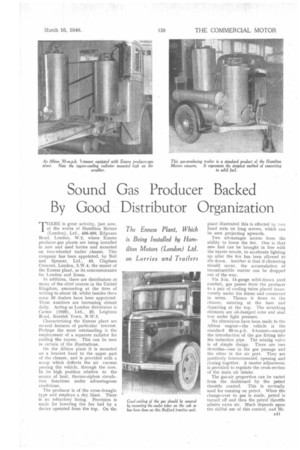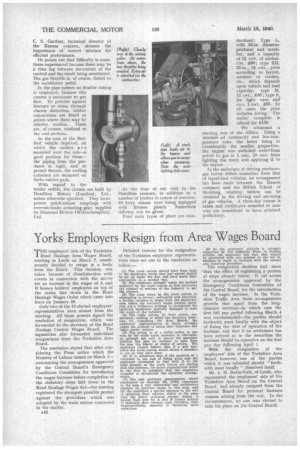Sound Gas Producer Backed By Good Distributor Organization
Page 43

Page 44

If you've noticed an error in this article please click here to report it so we can fix it.
The Enness Plant, Which is Being Installed by Hamilton Motors (London) Ltd. on Lorries and Trailers
THERE is great activity, just now, at the works of Hamilton Motors (London), Ltd., 466-490, Edgware Road, London, W.2, where Enness producer-gas plants are being installed in new and used lorries and mounted on two-wheeled trailer chassis. This company has been appointed, by Neil and Spencer. Ltd., 49, Clapham Crescent, London, S.W.4; the maker of the Enness plant, as its concessionnaire for London and Essex.
In addition, there are distributors at many of the chief centres in the United Kingdom, amounting at the time of writing to about 18, whilst besides these some 50 dealers have been appointed. These numbers are increasing almost daily. Acting as London distributor is Carmo• (1929), Ltd., 32, Leighton Road, Kentish Town, N.W.5.
Characterizing the Enness plant are several features of particular interest. Perhaps the most outstanding is the employment of a sepazate radiator for cooling the tuyere. This can be seen in certain of the illustrations.
On the Albion plant it is mounted on a bracket fixed to the upper part of the cleaner, and is provided with a scoop which deflects the air current passing the vehicle, through the core. In its high position relative to the source of heat, thermo-siphon circulation functions under advantageous conditions.
The producer is of the cross-draught type and employs a dry blast. There is no refractory lining. Provision is made for lowering the fire bed by a device operated from the top. On the plant illustrated this is effected by two hand nuts on long screws, which can be seen projecting upwards.
Two advantages accrue from the ability to lower the fire. One is that new fuel can be brought in line with the tuyere nozzle, to accelerate lighting up after the fire has been allowed to die down. Another is that if clinkering should occur, the accumulation of incombustible matter can be dropped out of the way.
Via 2-in. 14-gauge solid-drawn steel conduit, gas passes from the producer to a pair of cooling tubes placed transversely under the frame and connected in series. Thence it flows to the cleaner, entering at the base and departing at the top. The scrubbing elements are oil-damped coke and sisal tow under light pressure.
No alterations have been made to the Albion engine—the vehicle is the standard 30-m.p.h. 5-tomer—except the introduction of the gas fitting into the induction pipe. The mixillg valve is of simple design. There are two throttles—one in the gas passage and the other in the air port. They are positively interconnected, opening and closing together. A master adjustment is provided to regulate the cross-section of the main air intake.
The gas-air proportion can be varied from the dashboard by the petrol throttle control. This is normally used for running on petrol. When the change-over to gas is made, petrol is turned off and then the petrol throttle admits extra air. Much depends upon the skilful use of this control, and Mr.
C. S. Gardner, technical director of the Enness concern, stresses the importance of correct mixture for efficient performance.
He points out that difficulty is sometimes experienced because there may be a time lag between movement of the control and the result being manifested. The gas throttle is, of course, linked to the accelerator pedal.
In the pipe system no flexible tubing is employed, because this creates a resistance to gas flow. To provide against fracture or stress through chassis distortion, rubber connections are fitted at points where there may be relative motion. These are, of course, confined to the cool sections.
In the case of the Bedford vehicle depicted, on which the coolers a r e mounted over the cab—a good position for them— the piping from the producer is rigid, and to permit flexure, the cooling cylinders are mounted on Sorbo rubber pads.
With regard to the trailer outfits, the chassis are built by Hamilton Motors (London), Ltd., unless otherwise specified. They incorporate quick-release couplings with overrun-brake actuating gear, supplied by Diamond Motors (Wolverhampton), Ltd. At the time of our visit to the Hamilton concern, in addition to a number of trailers in course of erection, 10 lorry chassis were being equipped with Enness plants. Immediate delivery can be given.
Four main types of plant are stan dardized: Type L. with 18-in, diameter producer and scrubber, and a capacity of 2i cwt. of anthracite, £90; type EH, 22-in., 31t cwt., price according to layout, number of coolers. etc., which depends upon vehicle and load capacity; type M, 1/ cwt., £80 ; type S. for light vans and cars, 1 cwt., £65. In all cases the price includes fitting. The trailec complete is offered for £150.
We witnessed a starting test of the Albion. Using a mixture of anthracite and low-temperature coke, the latter being in considerably the smaller proportion. the engine was switched over, from petrol to gas in 1 min. 10 secs, from lighting the torch and applying it to the tuyere.
As the technique of driving producergas lorries differs somewhat from that of liquid-fuel vehicles, an arrangement has been made between the Enness company and the British School of Motoring, whereby tuition can be obtained in the driving and servicing of gas vehicles. A three-day course is taken and certificates awarded to men who are considered to have attained proficiency.




































































